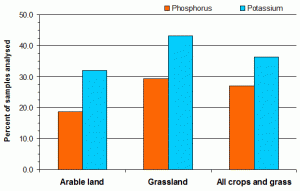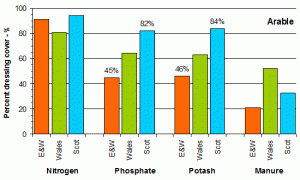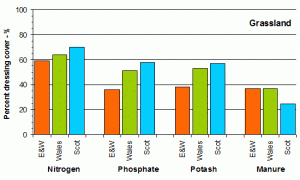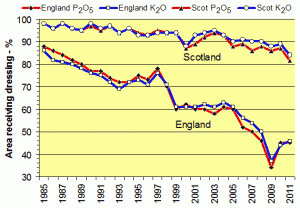Download pdf: Standard recommendations cannot make a poor soil good overnight (540.61K)
pdf 540.61K
Standard recommendations cannot make a poor soil good overnight
July 2012
A crop receiving the rate of potash (or phosphate) recommended in the Fertiliser Manual (RB209) for a soil at Index 0 or 1 is still very unlikely to perform as well as it could on an Index 2 soil. The standard recommendation at phosphorus (P) or potassium (K) Index 0 or 1 is in two parts: firstly an amount which is calculated to replace the quantities of phosphate and potash which will be removed at harvest, and secondly an extra amount, usually of 30 or 60 kg/ha at Index 1 or 0 respectively, which is to contribute to the correction of the soil deficiency. However this extra amount is a very small part of the true quantity which will be necessary to move an average soil from Index 0 or 1 into Index 2. Once the soil is at Index 2 it should be able to provide all the phosphate and potash required by most arable crops to achieve optimum yield, although a higher Index level is recommended for most field vegetable crops.

The additional 30 or 60 kg/ha of phosphate or potash applied where soils are at a low P or K Index is a relatively small surplus over the amount removed at harvest, and it will take between 10 and 20 years for such small annual additions to overcome the soil deficiency. The heavier the soil the more is needed, with the total quantities required being in the order of 300-350 kg/ha of phosphate (P2O5) or 450-500 kg/ha of potash (K2O) to raise the nutrient status of a medium soil by one Index, i.e. from the middle of Index 0 or 1 to the middle of Index 1 or 2. On heavier soils it may require a total over the years of almost a tonne of triple superphosphate or muriate of potash to raise a soil by one Index level.
Considerable attention was paid after World War II to raising the very low phosphate and potash status of soils in the UK, caused in part by the shortage of fertilisers during the war but also because productivity improvements were essential. By about the 1970s to 1980s soil deficiencies had been largely corrected. Since then however yields, and therefore nutrient offtakes, have increased significantly while the maintenance of soil P and K status has come to be seen as less important than the more complex management issues of nitrogen supply and the controlling of fungal diseases. As a result, a significant area of UK soil is now deficient in phosphate and/or potash, as shown by the PAAG report (Figure 1).
The 2010/11 PAAG report indicates that more than a quarter (28%) of all arable and grassland soils sampled were deficient in P and more than a third (36%) K deficient. This must be a matter of concern for those who work to optimise farm productivity and profitability. It is also a potential factor in reducing nitrogen use efficiency. A shortage of available potash will have an adverse effect on nitrogen use efficiency, and some of the N applied is likely to be wasted.


Adding to the pressure, the British Survey of Fertiliser Practice (BSFP) indicates that in England only about 45% of arable cropped land received a dressing of fertiliser phosphate or potash and only 36-38% of grassland received an application of these fertilisers (Figure 2). (21% and 37% of arable and grassland respectively received a dressing of manure). This surprising English information is in stark contrast to the practice in Scotland, where 82-84% of arable land and about 58% of grassland received phosphate and potash (Figure 3), with manure applications of 33% and 25% respectively. The fact that almost half the arable land in England does not appear to receive a dressing of P or K even to replace the nutrients removed at harvest adds to the significance of the nutrient deficiencies highlighted by the PAAG report.

The recent Defra Farm Practices Survey suggests that more than 90% of commercial arable farms in England regularly test the nutrient and pH status of their soils. Their corresponding figure for dairy and mixed farms is about 80%. While these findings relate specifically to farms in England, there is no reason to suppose that the intensity of soil sampling and analysis will be very different in other parts of the UK. The high level of soil sampling indicated by the Survey would suggest a high awareness of the importance of knowing the nutrient Index and status of soils for the optimisation of crop yields and quality.
If we assume that where soils are analysed and show a deficiency of P and/or K the decision is made to start to correct the deficiency, then the standard recommendation for action found in the Fertiliser Manual (RB209) recommends an additional 30 kg nutrient/ha over and above the quantity removed at harvest for soils at Index 1, and an extra 60 kg/ha where soils are at Index 0. The presumption that the cost of the fertiliser being used to correct the soil deficiency is added to the cost of replacing the quantity of nutrient removed by the crop at harvest naturally limits the amount which can be recommended. The crop should be expected to pay for the nutrients it removes but not for the improvement to the nutrient status of the field; that is an overall management cost, like drainage and liming.
Because in RB209 the two components of the recommendation are combined (quantity removed at harvest plus the extra to correct soil deficiency), the amount recommended for the correction of the deficiency is not large because the crop is expected to pay for it. As a result it may take many years of these small extra applications to correct the soil deficiency, depending on soil type. This unreasonably long timescale, during which yields and quality are likely to suffer, may help to explain why we still see significant areas of nutrient deficiency in the PAAG report.
The current strong cereal and oilseed rape prices provide an opportunity to take action to speed up the process of correcting a deficient soil by working a large dressing, maybe 100 kg P2O5/ha and/or 200 kg K2O/ha, into the soil before the next crop. Such an application should be considered as a field improvement expense; it should not be charged to the crop being grown, which should receive (and pay for) its normal recommended fertiliser dressing. Large dressings should not be applied close to seeds of course, but should be ploughed down, or worked well into the soil, with repeat dressings being applied as necessary. All dressings of phosphate must be applied with care to avoid losses to watercourses through surface run-off or via cracks in heavy soils. (PDA Calculator)
Is it OK to maintain soils at Index 1 rather than Index 2?
The recommendation to maintain arable soils at Index 2, or the SAC Moderate status in Scotland, is based on a very large amount of experimental work. This level of soil nutrient reserve has been considered to be an appropriate balance between the investment in the nutrient reserve and the risk of poor crop performance through shortage in nutrient availability. As with virtually all biological systems – and the soil:plant interaction is such a system – it is not possible to provide absolute definitions. A number of factors will influence whether Index 2 is appropriate or necessary, but most of these are only indicated as the crop is being established, or afterwards. Thus a crop which has the genetic potential to produce an extensive root system, such as winter cereals or oilseed rape, drilled into a good seedbed on soil with good structure will in all probability be able to yield to its maximum at P and K Index 1. However if the same crop has to be drilled during a very wet autumn, or into land which has been structurally damaged during the harvest of the previous crop, then the root system is likely to be restricted and the crop will require a more readily available supply of nutrient, i.e. it will ideally need an Index 2 soil. The same constraints will apply in difficult spring seasons.
It must be remembered that crops take up a large quantity of potassium as they grow, often considerably more than 300 kg K2O/ha. This is much more than the normal fertiliser application for a winter cereal or rape crop, and a good supply from the soil reserve is essential. The potash in the crop which is not removed at harvest in the grain (or straw) will be returned to the soil reserve and there is thus a large annual transfer, or flux, of potassium between the soil and the crop, and back again. It is clear that a large soil reserve, particularly of potassium, is essential. Traditionally the heavier soils were favoured for these crops because their potash reserves were usually better than the light soils, which were considered less than ideal.
As was discussed earlier, the small additional amount of potash recommended at soil K Indices of 1 or 0 represent only 10 or 20% of the crop needs, and cannot make up for a low reserve if growing conditions are not good and root growth is restricted. Many trials have also shown that an inadequate soil Index for the current crop cannot be fully compensated by the addition of fresh nutrient. It takes time for phosphate and potash to be distributed into the rooting zone and so be ‘found’ by the crop roots, although better recoveries can be achieved using appropriate fertiliser placement.
Within-field variability
Another major factor which argues against maintaining soils at an average field Index of 1 instead of 2 is the inevitable variability of the nutrient reserve within the field. If a field is maintained at an average Index 2, it is very probable that there will be areas in the field at Index 1 and also at Index 3 perhaps. The low areas at Index 1 are frequently associated with areas of higher yield because the higher nutrient offtakes at harvest will have reduced the soil reserves. Better-yielding areas will usually be associated with deeper, well-structured soil and so with crops with good root systems, i.e. crops which will be better at finding nutrients and so will be more tolerant of a lower reserve.
However, if the field average is maintained at Index 1, the within-field variability will probably mean that there are areas at Index 0 (and some at Index 2). These low areas are again likely to be potentially high-yielding, but at Index 0 they will almost certainly not yield to their potential. So while a field with good undamaged soil structure, drilled and growing in good conditions, will probably be OK at Index 1, the inevitable Index 0 areas in the field will not. If the average Index for the field is at Index 2, the low areas at Index 1 are much less likely to suffer from a nutrient deficiency, whereas an average Index 1 field with have areas which are almost certain to suffer from deficiency.
Risk and insurance
It is clear that there is a greater risk of nutrient deficiency if a field is maintained at Index 1 rather than Index 2. The insurance against this risk is to maintain the field at Index 2. This will mean that the field has a higher reserve of phosphate or potash, but this reserve still belongs to the farm. Except perhaps for some potash on very light sands, the reserve of phosphate or potash will remain in the soil and, provided that the quantities of nutrient removed at harvest are replaced, will provide an annual insurance at no additional cost. The only financial effect of managing a field at Index 1 will be the apparent saving on fertiliser inputs as the field declines from Index 2, but in fact this is simply a reduction in the asset value of the field. Once the field arrives at Index 1 the fertiliser inputs required are again those needed to replace removals, so no further apparent cost savings are made. The risk level has increased because the insurance from the lower asset value Index 1 field is not is not as effective.

